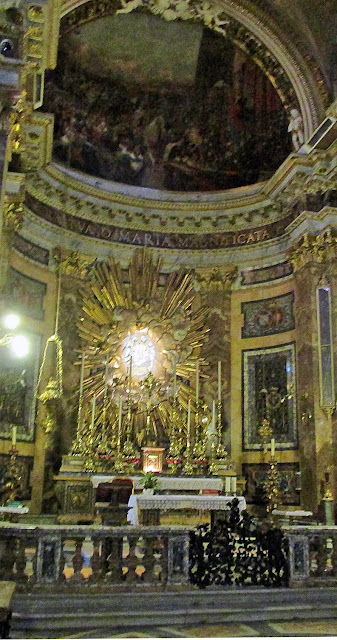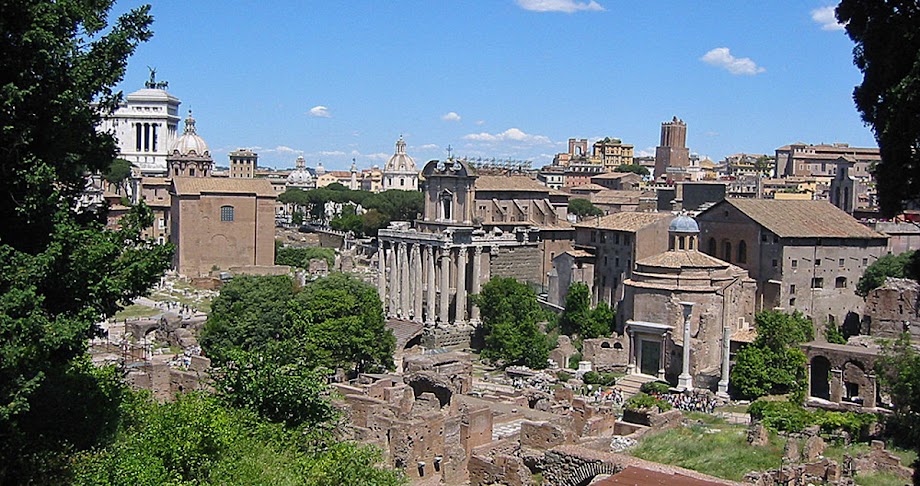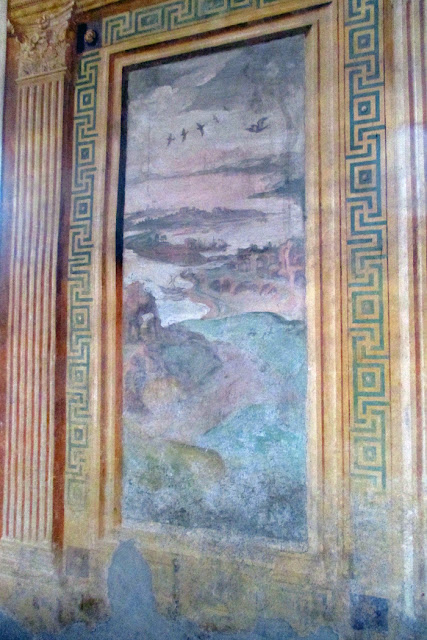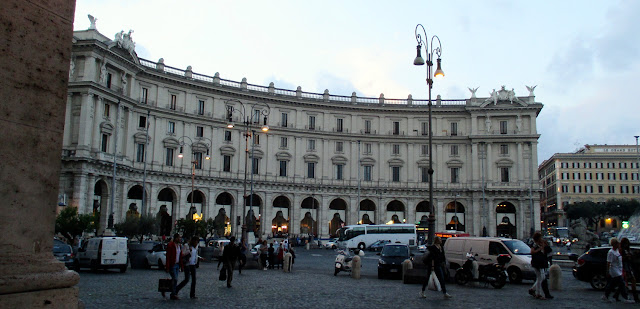The group was in a tour bus that I'm guessing seated 35-40 total. There were maybe 25 of us, tops, most quiet enough, though there was one middle-aged American woman who seemed incapable of shutting up. Before we started out she was jabbering at (not with) a British couple who were only allowed tacit agreements (not disagreements) with what she was saying. Fortunately when we started our tour guide began to speak, effectively stopping the drivel from the ugly American. (But, tell us what you REALLY think, Jack!)
 |
| Pines and olive trees near Hadrian's Villa |
There is not much left of what once was a huge complex. The very good model of what it probably looked like, in the information center, is just below:
For those of you who know or care about such things, the building on the far right at the bottom of the photo is a Roman theatre. At left of this buildings a long rectangle, on which if you look very carefully you can see a stage. The semicircle on the right is the auditorium, tiered seats. It is one of two theatres in this complex but little exists of either.
 |
| A good bit of the Villa in the distance |
One CAN see the remains of Hadrian's living quarters, which must have been luxurious at one time:
The slave quarters - and it took a lot of slaves to work on this place - are not so attractive, and seem to be cramped, partly underground, and not well ventilated;
A very well preserved building is that of the praetorian guards, the elite soldiers who watched over the emperor.
The Romans were very fond of baths and bathing, which is a probably a good thing. Two sets of baths, one large, the other small are some of the best preserved buildings on the site.
 |
| The Piccolo Terme, or small baths, at the Villa |
 |
| A closer look at the small baths. Forgive my imagination, but I make out a scary face in this photo - it was obviously not intended to be so, but the remains seem a little eerie to me. |
Here is a closer look at that column - I'd call it "endurance" under great odds:
Another example of endurance at the Villa are the olive trees. As our guide pointed out, it is no accident that there are so many olive trees in the complex - they are sacred, I suppose rightly so, as they provided much for the ancient Romans.
 |
| Consider this ancient, gnarled olive tree - as well as sacred, a symbol of endurance and resilience. |
I couldn't see the Egyptian influence much, but her reasoning makes sense, as it is dedicated to Antinous, the young man loved by Hadrian (whose wife apparently lived a very neglected existence). Antinous died under mysterious circumstances while in Egypt, drowning in the Nile River. Hadrian was beyond grief-stricken, so much so that he made Antinous a god. Not sure how that's done, but I suppose it's very good to be the Emperor! And if you believe in it, very good for Antinous after death.
 |
| Close to us on the right is a statue of an Amazon, and more towards the center is Mars, god of war |
 |
| The caryatids in the distance |
 |
| I love this little crocodile - at which one should never smile. |
 |
| Even more interesting is the turtle - areal one - at center, climbing up to rest I suppose. The photo is almost surreal because of all the reflections, of columns etc |
As we were leaving the Villa, our guide pointed to a distant hill, with a city on it:
 |
| That city is Tivoli, and it is our next stop, along with the Villa d'Este, its gardens and especially it's fountains. |
Tivoli, that is, and more specifically our destination in the center of that city is:
A bit of its indoors - amazing rooms as you'll see - more of its gardens, the actual gardens of which are less astounding than its many fountains.
The Villa is set on a pleasant sloping square
next to an old church
that of San Francesco (St Francis, fairly obviously, but just in case)
We were led into the courtyard (the former cloister of San Francesco) by our intrepid guide, who, despite our being the only tour group at hand, felt compelled to hold up her umbrella.
I don't mean that as a slight. She was a by-the-numbers sort of guide, every move calculated, and therefore quite clear, as was her slow, very well-pronounced English. For any former students of mine reading this, I couldn't help comparing her to Dr Timothy Kidd, longtime teacher of a course in our London Center that involved long Wednesday walks, each of which was packed with information about London and its great history of theatre.
As I noted above, we were on a four-hour tour. There was also a seven-hour option, too much for me, especially on the last day of a trip that had already included two full-day tours. This meant abbreviating our stay at the Villa d'Este. She showed us two very important rooms inside the villa, but focused more attention to the prime attraction, the exterior.
 |
| Part of the ceiling in the room of Hercules - his seven "labors" are all represented amid ornate embellishments |
and including a few frescoes from ancient days, faded, yes, but not bad for 2,000 years of age:
and, true to its name, another small, rustic fountain, with an elaborate mosaic on its wall:
The fountain and grotto from a bit of a distance, in order to see it set in the room:
There were plenty of other rooms to be explored, and those who wished were invited to and had a good hour to do so. But most of us headed out to the gardens, following our guide. We were met with this view:
And then we got a peek at one of the many fountains:
After chatting a bit about the loggia we were standing on
she showed us the Fontana dei Draghi (the Fountain of the Dragons) from the loggia
our guide took us down into the gardens/fountains. and introduced us to the street of 100 fountains:
What these lacked in size they more than made up for in number:
Let's just say I didn't bother to count.
The guide left us there to continue our explorations with a map of the gardens she gave each of us.
I first headed to the largest of them all - actually two fountains, one more or less atop the other:
 |
Other fountains in the gardens included the Fontana Rometta
and this beauty - of course the grottos in which the fountains are set are as important to the "picture" as the fountains themselves.
a closer look at the above, which is possibly the Fountain of Bacchus (god of wine, fertility etc - the Roman version of Dionysos)
And the beautiful Fountain of Tivoli, or the Oval Fountain:
Farther afield I found this grotto with a hermit inside - I relate to the hermit, as I sit and type this in my tiny apartment!
And then one of my very favorites, the Fountain of Diana of Ephesus, or the Mother Nature Fountain
obviously stressing fertility.
Two young women were there at the same time I was - I took a photo of them, they a photo of me, striking a pose:
still more - this "sweating" fountain, for instance:
As I headed back toward thé villa I was rewarded with views of the building itself:
and the surrounding countryside, this one filled with olive trees and vineyards:
as well as the fountains AND the villa - below is the Dragon Fountain:
and this, a fountain whose name I do not know:
Even without a fountain in the picture, the villa is impressive:
I took another look at the Dragon Fountain - if you look close, you can see that four dragons are spewing forth water - better that than fire I suppose.
And a last shot of the Neptune fountain, from the fish ponds:
And then it was time to leave, but I did stop in the city long enough to see for a moment another of its attractions, its castle
And the PUBLIC gardens in the city:
Love that arch, and the gorgeous pines.
On the bus ride back we passed the remains of ancient Roman aqueducts:
Which of course were vital for bringing water to Rome, and to rich families, like the d'Este, outside the city so they could show off beautiful fountains.
Meanwhile, back in Rome...I was impressed that we were only a little later than promised back in the city, arriving at about 1:30 pm. Had I chosen a full day tour I'd have been too exhausted to see any more of Rome - and that would have been a shame, as it was my last day.
I was more than ready for lunch. Why I chose to return to the Via Veneto and eat near where I had on my first day I do not know, but it was a mistake. The service was nearly non-existent, and the
list of ingredients was written "artichokes" (carciofi) of which there was one, like a cherry atop the salad. I had ordered the salad primarily for the artichokes (plural), so it was very disappointing to be allowed only one. Would that they had replaced several of the mediocre rolled meat, but alas, they did not. Also it was the dullest meal I had in Rome, and one of the two dullest in my entire three weeks in Europe - the other on that not very distinguished list happened to be the Ciao Bella, next door to my present choice the Trattoria Suggestum, where, to repeat, I had eaten on my first day in Rome.. May I suggest-umm...that if you ever find yourself in Rome, do not eat at Suggestum - or Ciao Bella!
After that disappointment I decided to visit another favorite place in the city, and one that was only a short easy walk from my trattoria - the Fontana di Trevi, or the Trevi Fountain, the Three Coins in a Fountain fountain. It was my last day, I'd join the crowds, toss a coin over my left shoulder into the waters of the Trevi, and lock in still another trip to Rome.
 |
| A road approaching the Trevi, following me an eager young couple |
 |
| The Fontana di Trevi, sans aqua - say it ain't SO, Antonio! |
This little beauty is one of those places to which I return every time I am in Rome. And while the interior of the church in general is quite lovely,
 |
| The high altar, slightly blurred I fear |
 |
| The ornate ceiling |
One of Bernini's greatest sculptures, perhaps even THE greatest: The Ecstasy of St Teresa. The spiritual ecstasy is apparent, but if you don't see the sensual ecstasy may I suggest you get your eyes checked? St Teresa, seemingly not quite on earth (it was claimed that the saint levitated on occasion), is in a swoon, the angel (cupid?) is just about to have at her with a spear (arrow?). Bernini did not, I am certain, mean for this to be bawdy. Instead he is showing spiritual ecstasy in the only way a human can, by carnalizing it. The result is brilliance, and a work of art that makes me gasp, as St Teresa seems to, every time I see it.
It is also highly theatrical, which would obviously speak to a theatrical fellow like myself. Consciously theatrical. Look on the far left and right of the photo - sitting in boxes, as at a theatre, are the donors, also sculpted by Bernini. They/we are witnessing a great drama here. I could go on, but by now you know I love it. So, enough said.
Upon leaving the church I decided that since I knew I could not top the Ecstasy, and since I was getting rather tired, I returned to the hotel and had a nap. Then I left for one last meal, at an interesting place that is a chain of sorts, called EATALY, a frankly touristic place, but not tacky-touristy.
There happened to be one of these very nearby, on the Piazza della Repubblica. I'm not sure that all of them are like this, but this EATALY consists of a shop in which you can buy food and drink from all over the country. You can also order it fresh to take away, or you could choose, as I did, to sit out under the balustrade of the piazza and be served , restaurant-style. I had taken out a delicious sandwich on one of the other days I was in Rome, and received very polite service at the counter, so why not? I sat down at an empty table but not yet bussed table, a very nice young woman came over almost immediately and cleaned it up for me.
I had a lovely view - there are twin curving balustrades on the Piazza della Repubblica, and I had a view across some traffic of the other, at twilight:
Unfortunately it looked as if a shift of waiters had just changed, from nice young women to abrupt young men. I
won't get into it, but suffice to say the service here was about as bad as it had been at the Suggestum earlier in the day. The FOOD however, was, as I had hoped, quite tasty. I decided to order basic Roman fare, bucatini all'amatriciana. It was just delicious, as was the red wine I ordered with it. The idiot servers forgot that I had ordered a salad as well, but at least I wasn't billed for it, and the food was so good I counted this last meal in Rome, and in Europe (this time around) as a good one.
So that was my time in Rome, which is now, has been and will ever be one of my favorite cities anywhere. Any city has its flaws, and Rome is far from free of them, but it was a wonderful way to end the trip. And to eat outside on an early October evening as twilight was giving way to night seemed to me a real treat And so, with this rather artsy image of what I was seeing as the skies darkened...
I'll say, good-bye to you my readers, and arrivaderci Roma!



















































No comments:
Post a Comment